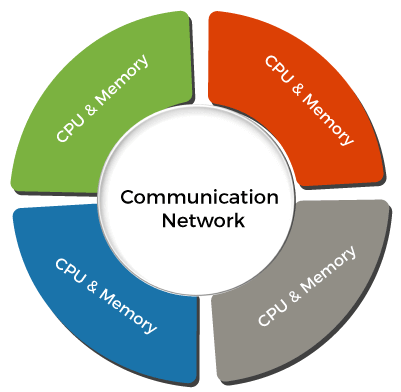Explain Different Distributed Computing System Models
A computing cluster consists of interconnected stand-alone computers which work cooperatively as a single integrated computing resource. In file-level transfer model the complete file is moved while a particular operation necessitates the file data to be transmitted all the way through the distributed computing network amongst client and server.

What Are Distributed Systems Architecture Types Key Components And Examples Toolbox Tech
Include the client-server model and the peer process model.

. The following are some of the more commonly used architecture models in distributed computing. Clusters peer-to-peer networks grids and clouds. Defines the components of the system the way they interact and the way the are deployed in a network of computers.
Whiteboard based groupware paradigm. It may have shared or distributed memory. Clusters of Cooperative Computers.
A computing cluster consists of interconnected stand-alone computers which work cooperatively as a single integrated computing resource. Classification of Distributed Computing Systems These can be classified into 4 groups. System Models for DS.
The information is available on the public board in the group whoever in the group can access it. Client-server model peer-to-peer model multilayered model multi-tier architectures service-oriented architecture SOA. The client-server architecture is the most common distributed system architecture which decomposes the system into two major subsystems or logical processes Client This is the first process that issues a request to the second process ie.
System Models for Distributed and Cloud Computing 1. Distributed Computing Models Overview. Anyone can read or write data to a shared display.
Many operations are performed simultaneously. Single computer is required. The peer-to-peer model consists of a collection of independent computers connected via a network.
- in some environment such as sensor networks the underlying. Physical Model Model that capture the hardware composition of a system in terms of computer and their interconnecting networks. There exist different models of distributed computing.
They are Minicomputer model Workstation model Workstation. Distributed system in a single descriptive model Three types of models Physical models. A distributed system contains multiple nodes that are physically separate but linked together using the network.
A diagram to better explain the distributed system is. Distributed Computing system models can be broadly classified into five categories. To explain the advantages and disadvantages of different distributed systems architectures To discuss client-server and distributed object architectures To describe object request brokers and the principles underlying the CORBA standards To introduce peer-to-peer and service-oriented architectures as new models of distributed computing.
The application layer defines the. System components are located at different locations. In the past 30 years users have experienced a natural growth path from Internet to.
A host can multicast to send data to all hosts in the group or part of the hosts in the group. This model has better scalability and is efficient. Herein what is distributed system model.
Define the main components of the system what their roles are and how they interact software 2. Capture the hardware composition of a system in terms of computers and other devices and their interconnecting network Architecture models. However the peer-to-peer model is an excellent one to explore the specific characteristics of distributed systems.
An architectural model of a distributed system defines the way in which the components of the system interact with each other and the way in which they are mapped onto an underlying network of computers. Multiple computers perform multiple operations. Message based groupware paradigm.
Processes coupled with appropriate interprocess communication paradigms two caveats. Distributed System Models is as follows. Three generations of distributed systems.
Fortunately most distributed systems employ one of a small set of common models. The different models that are used for building distributed computing systems can be classified as. For example we can see the World Wide Web itself as a distributed system model.
The minicomputer model is a simple extension of the centralized time-sharing system. Clusters peer-to-peer networks grids and clouds. Each of these nodes contains a small part of the distributed operating system software.
Only synchronous distributed systems are predictable in terms of timing. A distributed computing system based on this model consists of a few minicomputers interconnected by a communication network were each minicomputer usually has multiple users simultaneously logged on to it. System Models for Distributed and Cloud Computing These can be classified into 4 groups.
A computing cluster consists of interconnected stand-alone computers which work. Communicating entities are processes distributed system. Parallel Computing Distributed Computing.
Early distributed systems Internet-scale distributed systems. Explain System models for Distributed and cloud computing. Minicomputer Model Workstation Model Workstation Server Model Processor Pool Model and Hybrid Model 1 Minicomputer Model The minicomputer model is a simple extension of the centralized time-sharing system.
All the nodes in this system communicate with each other and handle processes in tandem. Three types of system models. Department of Applied Mathematics and Computer Science Architectural Models Communicating Entities System perspective.
In a synchronous distributed system there is a notion of global physical time with a known relative precision depending on the drift rate. Capture the hardware composition of a system in terms of computers and other devices and their interconnecting network. Byte-level transfer model Record-level transfer model 1File-level transfer model.
Architectural model describes responsibilities distributed between system components and how are these components placed. Due to the complex system architectures in distributed computing the term distributed systems is more often used. CORBA Contemporary distributed systems Isha Padhy Department of CSE CBIT Hyderabad 2.
Multiple processors perform multiple operations. First consider the software architecture of the components of a distributed system. Only such systems can be used for hard real-time applications.

What Are Distributed Systems Architecture Types Key Components And Examples Toolbox Tech
No comments for "Explain Different Distributed Computing System Models"
Post a Comment